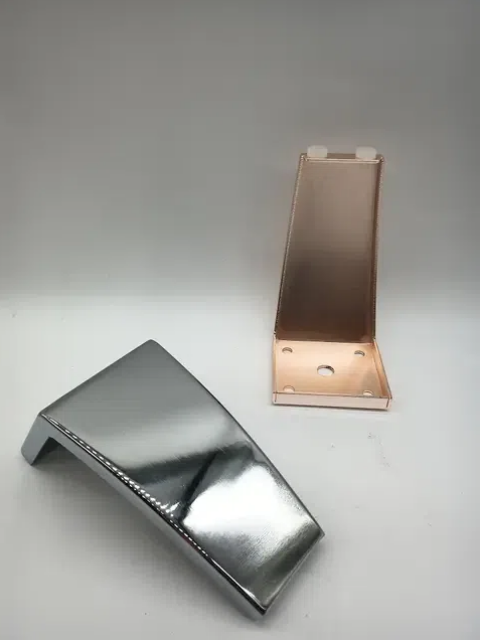Views: 0 Author: Site Editor Publish Time: 2025-07-24 Origin: Site









When designing furniture that needs to be both visually lightweight and structurally sound, the choice of leg material becomes more than just a technical decision—it’s a creative one. From the slender frames of a Fama Sofas recliner to the solid steel base of a Cassina statement table, every piece begins with a purpose, and that purpose often rests on the legs. For manufacturers like Kuki, helping clients choose between a furniture alloy leg or a furniture steel leg isn’t about one being better than the other—it’s about understanding which material best brings the design to life while meeting durability and aesthetic goals.
Furniture alloy legs typically consist of aluminum-based or aluminum-magnesium alloy composites engineered to optimize strength, weight, and corrosion resistance. These alloys combine the best of both worlds—lightweight yet durable materials that maintain their structural integrity under daily use. Spanish manufacturer Andreu World exemplifies this through its commitment to sustainability and ergonomic design. Their R&D department specifically works on aluminum-magnesium alloys to reduce the carbon footprint of their furniture while ensuring strength and flexibility.
The ecological advantage is notable: aluminum alloys are highly recyclable, reducing waste in production cycles. This makes them attractive for environmentally conscious furniture producers and consumers.
Besides material composition, finishing techniques greatly influence performance and appearance. Alloy legs can feature a variety of finishes including brushed aluminum, anodized coatings, or vibrant powder coatings. These finishing options give designers freedom to match modern interiors with sleek metallic tones or bold colors.
Spanish brand Actiu leverages alloy legs in height-adjustable desks and modular seating, designing components to be both ergonomic and transport-friendly. The lightness of alloys facilitates easy reconfiguration in office spaces, promoting a dynamic work environment that adapts to changing needs.
Moreover, the reduced weight of alloy legs lowers shipping costs and eases installation, which is an important consideration for manufacturers and buyers alike.

On the other side, furniture steel legs deliver unmatched strength and permanence. The density and rigidity of steel make it the preferred material for pieces that demand durability and a strong presence. Italian brand Poltrona Frau uses steel legs in its high-end executive desks and luxury seating where sturdiness is essential.
Steel legs excel in furniture that must support heavy loads over long periods—such as dining tables, conference room furniture, or modular sofa systems. Their ability to resist bending or deformation under stress surpasses most alloys, providing peace of mind in commercial or residential settings where reliability is paramount.
Steel also offers an extensive range of finishing possibilities. Minotti, for example, employs brushed steel legs with matte or polished chrome finishes to add refined elegance to modern furniture. Powder coating or painting extends protection against corrosion and allows customization to match any design language.
These finishes highlight steel’s raw industrial appeal or its polished luxury, depending on the intended aesthetic. Unlike the light, airy feel of alloy legs, steel legs evoke solidity and tradition, making them ideal for designs that emphasize classic style and robustness.
Alloy legs are especially suited for light, flexible, and ergonomically focused furniture designs. Spanish company Fama Sofas integrates alloy legs into their recliners and modular sofas, allowing for elegant curved shapes that save space without sacrificing comfort. Alloy’s corrosion resistance also enables usage in indoor-outdoor transitional spaces, balconies, or sunrooms where humidity might pose challenges for other metals.
The lightweight nature of alloys also supports easy furniture reconfiguration in small apartments, offices, or multi-functional living spaces, aligning with contemporary lifestyle demands.
For designs requiring imposing presence and heavy-duty performance, steel legs remain the go-to solution. B&B Italia, renowned for architectural and modular furniture, relies on steel legs to provide unwavering support for large seating and storage systems. Their durability ensures stability, even when furniture is rearranged or heavily used.
Steel’s capacity for customization—laser cutting, welding, and shaping—makes it indispensable in creating bespoke furniture pieces or statement designs that merge form and function.
Leading companies like Actiu and Andreu World invest heavily in research to improve alloy compositions, making furniture more sustainable and durable. Their innovations include reducing the density of alloys while increasing strength, enabling lighter yet tougher legs that meet ergonomic and environmental demands.
These advancements not only enhance product lifespan but also support global initiatives towards circular economies and eco-friendly manufacturing.
Quality assurance remains central to brands such as Molteni&C, which performs extensive testing on both alloy and steel legs. Stress tests simulate years of use, including weight-bearing, impact resistance, and corrosion exposure to ensure longevity. Such rigorous testing informs material selection for different furniture categories, optimizing performance and reliability.
At Kuki, similar quality controls guarantee every furniture alloy leg and furniture steel leg meets international standards, enabling customers worldwide to trust in our products’ safety and durability.
Selecting between a furniture alloy leg and a furniture steel leg depends on your design priorities, weight requirements, and durability expectations. Alloy legs shine in lightweight, ergonomic, and eco-friendly furniture applications, offering flexibility and modern finishes. Steel legs provide timeless strength, stability, and a broad palette of finishes suitable for statement and heavy-duty furniture.
Influenced by leading European brands like Fama Sofas, Molteni&C, Cassina, and Minotti, the choice becomes a matter of matching material qualities to your project’s vision and functional needs.
At Kuki, we deliver precision-crafted furniture alloy leg and furniture steel leg solutions tailored to your specifications. Explore our range and contact us to bring your furniture designs to life with materials that balance beauty and performance.
Contact us today to discuss your requirements and experience the difference of expertly engineered metal legs.





